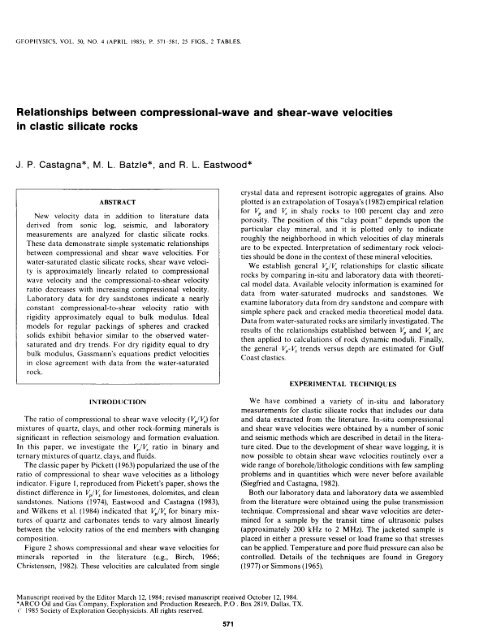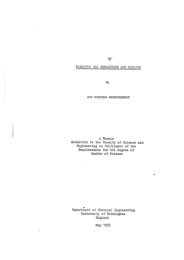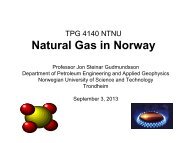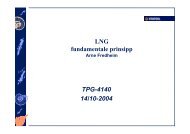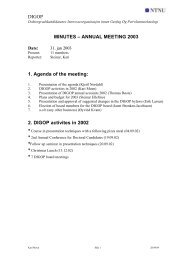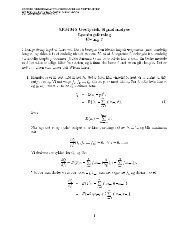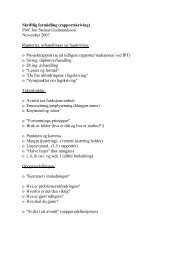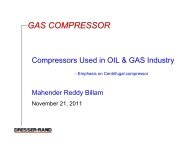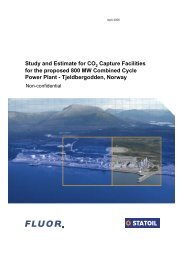Relationships between compressional-wave and shear-wave ...
Relationships between compressional-wave and shear-wave ...
Relationships between compressional-wave and shear-wave ...
Create successful ePaper yourself
Turn your PDF publications into a flip-book with our unique Google optimized e-Paper software.
geophysics VOL. 50, NO. 4 (APRIL 1985); P. 571-581, 25 FIGS., 2 TABLES.<br />
<strong>Relationships</strong> <strong>between</strong> <strong>compressional</strong>-<strong>wave</strong> <strong>and</strong> <strong>shear</strong>-<strong>wave</strong> velocities<br />
in elastic silicate rocks<br />
J. P. Castagna *, M. L. Batzle*, <strong>and</strong> R. L. Eastwood*<br />
ABSTRACT<br />
New velocity data in addition to literature data<br />
derived from sonic log, seismic, <strong>and</strong> laboratory<br />
measurements are analyzed for elastic silicate rocks.<br />
These data demonstrate simple systematic relationships<br />
<strong>between</strong> <strong>compressional</strong> <strong>and</strong> <strong>shear</strong> <strong>wave</strong> velocities. For<br />
water-saturated elastic silicate rocks, <strong>shear</strong> <strong>wave</strong> veloci-<br />
ty is approximately linearly related to <strong>compressional</strong><br />
<strong>wave</strong> velocity <strong>and</strong> the <strong>compressional</strong>-to-<strong>shear</strong> velocity<br />
ratio decreases with increasing <strong>compressional</strong> velocity.<br />
Laboratory data for dry s<strong>and</strong>stones indicate a nearly<br />
constant <strong>compressional</strong>-to-<strong>shear</strong> velocity ratio with<br />
rigidity approximately equal to bulk modulus. Ideal<br />
models for regular packings of spheres <strong>and</strong> cracked<br />
solids exhibit behavior similar to the observed water-<br />
saturated <strong>and</strong> dry trends. For dry rigidity equal to dry<br />
bulk modulus, Gassmann’s equations predict velocities<br />
in close agreement with data from the water-saturated<br />
rock.<br />
INTRODUCTION<br />
The ratio of <strong>compressional</strong> to <strong>shear</strong> <strong>wave</strong> velocity (VP/V,) for<br />
mixtures of quartz, clays, <strong>and</strong> other rock-forming minerals is<br />
significant in reflection seismology <strong>and</strong> formation evaluation.<br />
In this paper, we investigate the V’/V, ratio in binary <strong>and</strong><br />
ternary mixtures of quartz, clays, <strong>and</strong> fluids.<br />
The classic paper by Pickett (1963) popularized the use of the<br />
ratio of <strong>compressional</strong> to <strong>shear</strong> <strong>wave</strong> velocities as a lithology<br />
indicator. Figure 1, reproduced from Pickett’s paper, shows the<br />
distinct difference in V,/V, for limestones, dolomites, <strong>and</strong> clean<br />
s<strong>and</strong>stones. Nations (1974) Eastwood <strong>and</strong> Castagna (1983)<br />
<strong>and</strong> Wilkens et al. (1984) indicated that VP/V, for binary mixtures<br />
of quartz <strong>and</strong> carbonates tends to vary almost linearly<br />
<strong>between</strong> the velocity ratios of the end members with changing<br />
composition.<br />
Figure 2 shows <strong>compressional</strong> <strong>and</strong> <strong>shear</strong> <strong>wave</strong> velocities for<br />
minerals reported in the literature (e.g., Birch, 1966;<br />
Christensen, 1982). These velocities are calculated from single<br />
Manuscript received by the Editor March 12, 1984; revised manuscript received October 12, 1984.<br />
*ARC0 Oil <strong>and</strong> Gas Company, Exploration <strong>and</strong> Production Research, P.0 Box 2819, Dallas, TX<br />
i’ 1985 Society of Exploration Geophysicists. All rights reserved.<br />
571<br />
crystal data <strong>and</strong> represent isotropic aggregates of grains. Also<br />
plotted is an extrapolation of Tosaya’s (1982) empirical relation<br />
for VP <strong>and</strong> V, in shaly rocks to 100 percent clay <strong>and</strong> zero<br />
porosity. The position of this “clay point” depends upon the<br />
particular clay mineral, <strong>and</strong> it is plotted only to indicate<br />
roughly the neighborhood in which velocities of clay minerals<br />
are to be expected. Interpretation of sedimentary rock veloci-<br />
ties should be done in the context of these mineral velocities.<br />
We establish general VP/V, relationships for elastic silicate<br />
rocks by comparing in-situ <strong>and</strong> laboratory data with theoreti-<br />
cal model data. Available velocity information is examined for<br />
data from water-saturated mudrocks <strong>and</strong> s<strong>and</strong>stones. We<br />
examine laboratory data from dry s<strong>and</strong>stone <strong>and</strong> compare with<br />
simple sphere pack <strong>and</strong> cracked media theoretical model data.<br />
Data from water-saturated rocks are similarly investigated. The<br />
results of the relationships established <strong>between</strong> VP <strong>and</strong> V, are<br />
then applied to calculations of rock dynamic moduli. Finally,<br />
the general VP-< trends versus depth are estimated for Gulf<br />
Coast elastics.<br />
EXPERIMENTAL TECHNIQUES<br />
We have combined a variety of in-situ <strong>and</strong> laboratory<br />
measurements for elastic silicate rocks that includes our data<br />
<strong>and</strong> data extracted from the literature. In-situ <strong>compressional</strong><br />
<strong>and</strong> <strong>shear</strong> <strong>wave</strong> velocities were obtained by a number of sonic<br />
<strong>and</strong> seismic methods which are described in detail in the litera-<br />
ture cited. Due to the development of <strong>shear</strong> <strong>wave</strong> logging, it is<br />
now possible to obtain <strong>shear</strong> <strong>wave</strong> velocities routinely over a<br />
wide range of borehole/lithologic conditions with few sampling<br />
problems <strong>and</strong> in quantities which were never before available<br />
(Siegfried <strong>and</strong> Castagna, 1982).<br />
Both our laboratory data <strong>and</strong> laboratory data we assembled<br />
from the literature were obtained using the pulse transmission<br />
technique. Compressional <strong>and</strong> <strong>shear</strong> <strong>wave</strong> velocities are deter-<br />
mined for a sample by the transit time of ultrasonic pulses<br />
(approximately 200 kHz to 2 MHz). The jacketed sample is<br />
placed in either a pressure vessel or load frame so that stresses<br />
can be applied. Temperature <strong>and</strong> pore fluid pressure can also be<br />
controlled. Details of the techniques are found in Gregory<br />
(1977) or Simmons (1965).
FIG. 1. Laboratory measurements on limestones? dolomites,<br />
<strong>and</strong> s<strong>and</strong>stones from Pickett (1963). VP = compressronal veloci-<br />
ty, v, = <strong>shear</strong> velocity.<br />
0.0 0.5 1.0 1.5 2.0 2 5 3.0 35 4.0 45 50<br />
vs (KM i SEC)<br />
FIG. 2. Compressional <strong>and</strong> <strong>shear</strong> velocities for some minerals.<br />
lm d,o VS’ KM I SEC<br />
GREEN RIVER SH*LE; POOIO. GREGORY. AN0 GRAY (1988,<br />
. AXIAL LO*owG 10,cca PSI Yp= 4.39. “s,=“s,=2.42<br />
. HYoRosTATlC LO*DING. 10,mPsI “p=4_4.“s,= 2.wJ.vs, = 2.64<br />
TOSAYA HW<br />
OCLAY POINT VP = 3.4, Y* = 1.6<br />
0 COTTON “ALLEY SILTSTONE<br />
0 PIERRE SHALE<br />
X ARM DATA<br />
FIG. 3. Ultrasonic laboratory measurements for various mud-<br />
rocks.<br />
Castagna et al.<br />
OBSERVATIONS IN MUDROCKS<br />
We define mudrock as elastic silicate rock composed pri-<br />
marily of clay- or silt-sized particles (Blatt et al., 1972). Lithified<br />
muds are composed primarily of quartz <strong>and</strong> clay minerals.<br />
Owing to the difficulty associated with h<strong>and</strong>ling of most<br />
mudrocks, laboratory measurements on these rocks are not<br />
commonly found in the literature. Measurements that do exist<br />
are generally biased toward highly lithified samples.<br />
Figure 3 is a V,-versus-V, plot of laboratory measurements<br />
for a variety of water-saturated mudrocks. For reference, lines<br />
are drawn from the clay-point velocities extrapolated from<br />
Tosaya’s data (VP = 34 km/s, C; = i.6 kmjsj to caicite <strong>and</strong><br />
quartz points. The data are scattered about the quartz-clay line,<br />
suggesting that I$ <strong>and</strong> V, are principally controlled by mineral-<br />
ogy.<br />
In-situ sonic <strong>and</strong> field seismic measurements in mudrocks<br />
(Figure 4) form a well-defined line given by<br />
VP = 1.16v, + 1.36, (1)<br />
where the velocities are in km/s. In view of the highly variable<br />
composition <strong>and</strong> texture of mudrocks, the uniform distribution<br />
of these data is surprising. We believe this linear trend is<br />
explained in part by the location of the clay point near a line<br />
joining the quartz point with the velocity of water. We hypoth-<br />
esize that, as the porosity of a pure clay increases, compres-<br />
sional <strong>and</strong> <strong>shear</strong> velocities decrease in a nearly linear fashion as<br />
the water point is approached. Similarly, as quartz is added to<br />
pure clay, velocities increase in a nearly linear fashion as the<br />
quartz point is approached. These bounds generally agree with<br />
those inferred from the empirical relations of Tosaya (1982); the<br />
exception is for behavior at very high porosities. The net result<br />
is that quartz-clay-water ternary mixtures are spread along an<br />
l.O-<br />
00<br />
.<br />
I I I I I I I<br />
0.0 0.5 1.0 1.5 2.0 2.5 3.0 35<br />
vs, KMlSEC<br />
n KOERPERICH, 1979, SILTSTONE, SONIC LOG (15 KHZ)<br />
0 EASTWOOD AND CASTAGNA. 1983. WOLFCAMP SHALE. SONIC LOG (10 KHz)<br />
A OIL SHALE. SONIC LOG. (25 KHz,<br />
+ LlNGLE AND JONES. 1977. DEYONIAN SHALE, SONIC LOG<br />
+ HAMILTON, 1979, PIERRE SHALE<br />
0 HAMILTON. ,979, GRAYSON SHALE<br />
0 HPIMILTON. 1979. JAPANESE SHALE<br />
. LASH, 1980. GULF COAST SEDIMENTS, VERTICAL SEISMIC PROFILE<br />
A SHALE, SONIC LOG, INVERTED STONELEY WAVE VELOCITIES. (1 KHZ,<br />
-... HAMILTON. ,979. MUDSrONES<br />
--- ESENIRO, 1981. GULF co*.9 SEDIMENTS. SURF*CE WAVE INVERSION<br />
@ TOSAY*‘S “CLAY” POINT (EXTR*POLATION FROM L*BOR*ToRY OAT*,<br />
FIG. 4. Compressional <strong>and</strong> <strong>shear</strong> <strong>wave</strong> velocities for mudrocks<br />
from in-situ sonic <strong>and</strong> field seismic measurements.
elongate triangular region loosely defined by clay-water,<br />
quartz-clay, <strong>and</strong> quartz-water lines.<br />
Figure 4 <strong>and</strong> equation (1) indicate that V,iK for mudrocks is<br />
highly variable, ranging from less than 1.8 in quartz-rich rocks<br />
to over 5 in loose, water-saturated sediments. This is a direct<br />
result of the nonzero intercept at the water point.<br />
Compressional <strong>and</strong> <strong>shear</strong> <strong>wave</strong> velocities obtained by sonic<br />
logging in geopressured argillaceous rocks of the Frio forma-<br />
tion that exhibit clay volumes in excess of 30 percent, as deter-<br />
mined by a neutron-density crossplot, are plotted in Figure 5.<br />
Most of the data are consistent with equation (1) <strong>and</strong> Figure 4.<br />
Figure 6 is a plot of sonic log data in shaly intervals reported by<br />
Kithas (1976). As with Figure 5, these data are well described by<br />
equation (1).<br />
OBSERVATIONS IN SANDSTONES<br />
The trend of Pickett’s (1963) laboratory data for clean watersaturated<br />
s<strong>and</strong>stones (Figure 7) coincides precisely with equation<br />
(1) established for mudrocks. The correspondence of V,/V,<br />
for s<strong>and</strong>stones <strong>and</strong> mudrocks is not entirely expected. Figure 8<br />
is a plot of sonic log V, <strong>and</strong> v, data in s<strong>and</strong>stones exhibiting less<br />
than 20 percent neutron-density clay volume in the Frio formation.<br />
Except for some anomaloud, c ~1 !ow !/,!Ys ratios~ indicative<br />
of a tight gas s<strong>and</strong>stone (verified by conventional log analysis),<br />
the data again fall along the water-saturated line established for<br />
mudrocks. Also falling along this line are sonic velocities for an<br />
orthoquartzite reported by Eastwood <strong>and</strong> Castagna (1983).<br />
In-situ measurements for shallow marine s<strong>and</strong>s compiled by<br />
Hamilton (1979) fall above the line. Sonic log velocities reported<br />
by Backus et al. (1979) <strong>and</strong> Leslie <strong>and</strong> Mons (1982) in clean<br />
porous brine s<strong>and</strong>s tend to fall slightly below the line (Figure 9).<br />
Figure 10 is a compilation of our laboratory data for watersaturated<br />
s<strong>and</strong>stones with data from the literature (Domenico,<br />
1976: Gregory, 1976; King, 1966; Tosaya, 1982; Johnston,<br />
1978; Murphy, 1982; Simmons, 1965: Hamilton 1971). To first<br />
order, the data are consistent with equation (1); however, they<br />
are significantly biased toward higher V, for a given VP. The<br />
location of some s<strong>and</strong>stone data on the mudrock watersaturated<br />
line, although other data fall below this line, is presumably<br />
related to the s<strong>and</strong>stone texture <strong>and</strong>/or clay content.<br />
Following the lead of Tosaya (1982) we used multiple linear<br />
regression to determine the dependence of sonic <strong>wave</strong>formderived<br />
<strong>compressional</strong> <strong>and</strong> <strong>shear</strong> <strong>wave</strong> velocity on porosity <strong>and</strong><br />
clay content for the Frio formation. We applied conventional<br />
log analysis to determine porosity <strong>and</strong> volume of clay (V,,) from<br />
gamma ray, neutron, <strong>and</strong> density logs. The resulting relationships<br />
for the Frio formation are<br />
<strong>and</strong><br />
V,, (km/s) = 5.81 - 9.42+ - 2.21 V,, (2a)<br />
V, (km/s) = 3.89 - 7.07+ - 2.04V,, (2b)<br />
The correlation coefficient r for both of these relationships is<br />
.96. The equations of Tosaya (1982) for laboratory data are<br />
<strong>and</strong><br />
V,, (km/s) = 5.8 - 8.64 - 2.4V,, , w<br />
V, (km/s) = 3.7 - 6.34 - 2.1 V,, (24<br />
The similarity <strong>between</strong> our equations <strong>and</strong> Tosaya’s is evident.<br />
P-<strong>wave</strong> <strong>and</strong> S-<strong>wave</strong> Velocities in Clastic Rocks 573<br />
FIG. 5. Compressional <strong>and</strong> <strong>shear</strong> <strong>wave</strong> velocities for geo-<br />
pressured shaly rocks of the Trio formation from sonic logs.<br />
FIG. 6. Sonic data from Kithas (1976) mostly for shales.<br />
FIG. 7. Trend of s<strong>and</strong>stone <strong>compressional</strong> <strong>and</strong> <strong>shear</strong> <strong>wave</strong> ve-<br />
locities from Pickett (1963).<br />
From Tosaya’s equations the sonic properties of zero poros-<br />
ity clay are: P-<strong>wave</strong> transit time = 89.6 us/ft, S-<strong>wave</strong> transit<br />
time = 190.5 us/ft, <strong>and</strong> VP/L; = 2.125. The corresponding<br />
values for the Frio formation clay are: P-<strong>wave</strong> transit<br />
time = 84.7 us,/ft, S-<strong>wave</strong> transit time = 165.1 ps/ft, <strong>and</strong><br />
v,.:‘v, = 1.95.
IO-<br />
0.0<br />
. EASTwoclD a CASTAGNA (lsss,. 0RTHoo”ARRITE. SONIC LOG. 10 KHZ<br />
0 FM0 FORMATION SANDSTONES, SONIC LOG (IS KHz,<br />
--- “MAlLTON (?WS,, SANDS<br />
FIG. 8. Sonic log velocities in s<strong>and</strong>stones.<br />
00<br />
(4<br />
I I I I I I I<br />
0.5 1.0 1.5 2.0 2.5 3.0 3.5<br />
VS’ KM I SEC<br />
W<br />
FIG. 9. Sonic log velocities for clean water-saturated s<strong>and</strong>-<br />
stones. (a) Backus et al. (1979),(b) Leslie <strong>and</strong> Mons (1982).<br />
Castagna et al.<br />
0.0 0.5 10 1.5 20 2.5 3.0 3.5 4.0<br />
v,. KM I SEC<br />
FIG. 10. Compilation of laboratory data for water-saturated<br />
s<strong>and</strong>stones, including ARC0 <strong>and</strong> literature data.<br />
Some algebraic manipulation yields equations which ex-<br />
plicitly reveal the dependence of V,/V, on porosity <strong>and</strong> volume<br />
of clay. From equations (2a) <strong>and</strong> (2b) we get<br />
for clean s<strong>and</strong> <strong>and</strong><br />
c;;v, = 1.33 + .63/(3X9 - 7.074)<br />
(3a)<br />
VP/V, = 1.08 + 1.61/(3X9 - 2.04v,,) (3b)<br />
for zero-porosity s<strong>and</strong>/clay mixtures. These equations reveal<br />
that increasing porosity or clay content increases VP/V, <strong>and</strong> that<br />
the velocity ratio is more sensitive to porosity changes.<br />
DRY SANDSTONES:<br />
LABORATORY DATA AND IDEAL MODELS<br />
According to Gregory (1977) Poisson’s ratio is about 0.1<br />
(corresponding to V,,/V, o 1.5) for most dry rocks <strong>and</strong> un-<br />
consolidated s<strong>and</strong>s, <strong>and</strong> it is independent of pressure. Figure 11<br />
is a crossplot of V,,/V, versus VP for dry <strong>and</strong> water-saturated<br />
Berea s<strong>and</strong>stone. Note that the water-saturated points are rea-<br />
sonably close to the relationship defined by equation (I),<br />
whereas the dry points are nearly constant at a VP/V, of about<br />
1.5. Figure 12 is a compilation of laboratory <strong>compressional</strong> <strong>and</strong><br />
<strong>shear</strong> <strong>wave</strong> velocities for dry s<strong>and</strong>stones. The field data of<br />
White (1965) for loose s<strong>and</strong>s also are included. The data fit a<br />
line having a constant VP/K ratio of 1.5.<br />
We gain some insight into the behavior of dry s<strong>and</strong>stones by<br />
considering various regular packings of spheres. The reader is<br />
referred to White (1965) <strong>and</strong> Murphy (1982) for a detailed<br />
discussion. The dry <strong>compressional</strong> (V,“) to <strong>shear</strong> (Vf) velocity<br />
ratio, as a function of Poisson’s ratio (v) of solid spheres, is<br />
v,D,!v,D = [(2 - v)/(l - v)]’ 2 (4a)<br />
for a simple cubic packing (SC) of spheres;<br />
V;I’Vp = [4(3 - v)/(6 ~ 5~)]‘:~ (4b)<br />
for a hexagonal close packing (HCP) of spheres; <strong>and</strong><br />
v;/v,; = J5 (4c)<br />
for a face-centered cubic (FCC) packing. For HCP <strong>and</strong> FCC<br />
packings propagation directions are (I, 0, 0).
These- rtia’rions are valid~ only at elevated confining pres%res<br />
when the packings have sufficiently high bulk <strong>and</strong> <strong>shear</strong> moduli<br />
to propagate elastic <strong>wave</strong>s. The velocity ratio cancels the pres-<br />
sure dependence: however, this pressure restriction should be<br />
kept in mind.<br />
From equations (4a) through (4~) we see that dry V,/V, is<br />
constant or dependent only upon Poisson’s ratio of the spheres<br />
(v). For quartz spheres (v Y O.l), dry V,,/V, is virtually the same<br />
for these packings (FCC = 1.41, HCP = 1.43, SC = 1.45).<br />
Dry V’/V, ratios based on these regular packings of spheres<br />
(Figure 13) indicate that the elastic properties of the grains are<br />
of secondary importance. The maximum range of dry V’/< is<br />
for SC, <strong>and</strong> varies only from $ to 4 when Poisson’s ratio of<br />
the spheres varies from 0 to 0.5. For all practical purposes, dry<br />
VP/V, for packings of common rock-forming minerals is from<br />
1.4 to 1.5.<br />
For real rocks, of course, a number of complicating factors<br />
must be considered. One of these is the presence of micro-<br />
fractures or pores of low aspect ratio. One means of studying<br />
the effects of microfractures is to make velocity measurements<br />
on samples before <strong>and</strong> after cracking by heat cycling. Figure 14<br />
shows the results of heat cycling on dry s<strong>and</strong>stones obtained by<br />
Aktan <strong>and</strong> Farouq Ali (1975). The effect of the addition of<br />
microfractures is to reduce both <strong>compressional</strong> <strong>and</strong> <strong>shear</strong> <strong>wave</strong><br />
velocities in a direction parallel to the dry line, maintaining a<br />
nearly constant VP/V,.<br />
Further insight into the effect of microfractures is provided<br />
by modeling the elastic moduli of solids with various pore<br />
aspect ratio spectra utilizing the formulation of Toksijz et al.<br />
(1976). This theory assumes r<strong>and</strong>omly oriented <strong>and</strong> distributed<br />
noninteracting elliptical pores <strong>and</strong>, therefore, may not be valid<br />
for highly porous or shaly rocks.<br />
As an example, we computed the V,ll( relationship for the<br />
inverted Boise s<strong>and</strong>stone pore spectrum (Cheng <strong>and</strong> Toksiiz,<br />
1976). This was done by maintaining the same relative con-<br />
centrations among the aspect ratio distribution but uniformly<br />
increasing the entire distribution to increase the total porosity.<br />
Our intent was to show that aspect ratio distributions thought<br />
to be characteristic of actual rocks produce behavior in close<br />
agreement with observed trends. We do not imply that these<br />
distributions are quantitatively applicable to real rocks. Except<br />
FIG. 11. Ultrasonic measurements of V IV, for a dry <strong>and</strong> water-<br />
saturated Berea s<strong>and</strong>stone sample. I%e various points were<br />
obtained at different effective pressures.<br />
P-<strong>wave</strong> <strong>and</strong> S-<strong>wave</strong> Velocities in Clastic Rocks 575<br />
FIG. 12. Laboratory measurements for V, <strong>and</strong> V’ for dry s<strong>and</strong>-<br />
stones. Note that one s<strong>and</strong>stone with calcite cement plots well<br />
above the line.<br />
FIG. 13. Calculated V/V, for regular packings of spheres versus<br />
Poisson’s ratio (v) of the sphere material. SC = simple cubic<br />
packing, HCP = hexagonal close packing, FCC = face-<br />
centered cubic packing.<br />
FIG. 14. The results of Aktan <strong>and</strong> Farouq Ali (1975) for several<br />
dry s<strong>and</strong>stones before <strong>and</strong> after heat cycling. Data are plotted<br />
for measurements at high <strong>and</strong> low confining pressures.
576 Castagna et al.<br />
FE. 15. Calculated I$ <strong>and</strong> V,,from the formulation of Cheng<br />
<strong>and</strong> Toksoz (1979) usmg the mverted pore aspect ratio spec-<br />
trum of Boise s<strong>and</strong>stone.<br />
FE. 16. Ultrasonic laboratory data for various s<strong>and</strong>stones<br />
under both dry <strong>and</strong> saturated conditions. Dry (open symbols)<br />
<strong>and</strong> saturated (solid symbols) data are plotted for the same<br />
effective pressure conditions <strong>and</strong> joined by tie lines.<br />
for high crack concentrations (low velocities) where the limits of<br />
the model may be exceeded, the computed line for dry Boise<br />
s<strong>and</strong>stone is in excellent agreement with the observed dry s<strong>and</strong>-<br />
stone line (Figure 15). It is interesting to note that an identical<br />
computed line is obtained when all cracks with pore aspect<br />
ratios less than 0.1 are closed. This is consistent with the results<br />
of Atkan <strong>and</strong> Farouq Ali (1975) shown in Figure 14. The<br />
addition of microfractures to a dry rock lowers k’, <strong>and</strong> k’,, but<br />
does not change the V,lV, ratio appreciably.<br />
To summarize, we examined two extreme cases for dry rocks<br />
by two different models: (1) regular packings of spheres <strong>and</strong> (2)<br />
cracked solids. Both models predict a nearly constant VP/V, for<br />
dry s<strong>and</strong>stone, which is consistent with experimental observa-<br />
tion.<br />
SATURATED SANDSTONES:<br />
LABORATORY DATA AND IDEAL MODELS<br />
Figure 16 shows VP/V, relationships for dry <strong>and</strong> water-<br />
saturated s<strong>and</strong>stones. Lines join measurements made on single<br />
dry <strong>and</strong> water-saturated samples under the same effective pres-<br />
sure conditions. Qualitatively, the data from water-saturated<br />
s<strong>and</strong>stones are consistent with equation (1) but tend toward<br />
higher V, for a given VP.<br />
Given the <strong>compressional</strong> <strong>and</strong> <strong>shear</strong> <strong>wave</strong> velocities obtained<br />
in the laboratory for dry s<strong>and</strong>stones, we use Gassmann’s (195 1)<br />
equations to compute velocities when these rocks are saturated<br />
with water. Gassmann’s equations are:<br />
<strong>and</strong><br />
KD + Q<br />
K,= KS-----<br />
&+Q'<br />
K,(Ks - KD)<br />
Q = $(Ks - KF) ’<br />
(5b)<br />
hV = PO> (5c)<br />
pw = @PF + (1 - $)I%, (5d)<br />
where K, is the bulk modulus of the wet rock, K, is the bulk<br />
modulus of the grains, K, is the bulk modulus of the dry frame,<br />
K, is the bulk modulus of the fluid, uw is the <strong>shear</strong> modulus of<br />
the wet rock, pD is the <strong>shear</strong> modulus of the dry rock, pw is the<br />
density of the wet rock, pr is the density of the fluid, ps is the<br />
density of the grains, <strong>and</strong> 4 is the porosity. Figure 17 is a plot of<br />
computed (from Gassmann’s equations) <strong>and</strong> measured saturated<br />
<strong>compressional</strong> <strong>and</strong> <strong>shear</strong> <strong>wave</strong> velocities. Although the<br />
individual points do not always coincide, the computed <strong>and</strong><br />
measured data follow the same trend.<br />
We also can apply Gassmann’s equations to the equations<br />
for dry regular packing arrangements of spheres given by<br />
Murphy (1982). Figure 18 shows the relationship <strong>between</strong> VP<br />
<strong>and</strong> V, for water-saturated SC, HCP, <strong>and</strong> FCC packings. Note<br />
that the packings of equal density (FCC <strong>and</strong> HCP) yield virtually<br />
the same curve. The curves obtained for these simple<br />
packings are qualitatively consistent with the low-velocity experimental<br />
data of Hamilton (197 1) <strong>and</strong> Domenico (1976).<br />
For water-saturated rock, the formulation of Toksoz et al.<br />
(1976) predicts that the addition of microfractures will change<br />
the V,,-b’c relationship (Figure 19). The inverted Boise s<strong>and</strong>stone<br />
pore aspect ratio spectrum yields a line close to equation (1).<br />
Closing all cracks with aspect ratios less than 0.1 yields a line<br />
which lies below equation (1). Thus, we might expect data for<br />
clean porous s<strong>and</strong>stones dominated by equant porosity to he<br />
slightly below the line defined by equation (l), whereas tight<br />
s<strong>and</strong>stones with high concentrations of elongate pores would<br />
tend to lie along this line. Verification of this hypothesis is left<br />
as an objective of future research.<br />
A good description of the water-saturated VP-Vs relationship<br />
for s<strong>and</strong>stones is provided by the following formulation. The<br />
dry line established with laboratory data (VP/V, z 1.5) means<br />
that dry bulk modulus (K,) is approximately equal to dry<br />
rigidity (uD)<br />
These are exactly equal when<br />
From equation (5~) it follows that<br />
PO z K,. (6)<br />
v;:vp = 1.53. (7)<br />
K D=~D=~W~<br />
Thus, the saturated <strong>shear</strong> velocity can be obtained from the dry<br />
bulk modulus by<br />
(8)
The wet bulk modulus is given by<br />
P-<strong>wave</strong> <strong>and</strong> S-<strong>wave</strong> Velocities in Clastic Rocks 577<br />
Kw = pw(V; - $Vf). (10)<br />
Equations (9) <strong>and</strong> (10) <strong>and</strong> Gassmann’s equations [(5a) through<br />
(5d)] allow computation of V, given VP, I$, <strong>and</strong> the grain <strong>and</strong><br />
fluid densities <strong>and</strong> bulk moduli.<br />
We computed <strong>shear</strong>-<strong>wave</strong> velocities for s<strong>and</strong>stone core po-<br />
rosities <strong>and</strong> sonic log <strong>compressional</strong> velocities given by Gre-<br />
gory et al. (1980) for depths from 2 500 to 14 500 ft in two wells<br />
500 ft apart in Brazoria County, Texas. Figure 20 shows that<br />
the resulting VP-q relationship is in excellent agreement with<br />
our s<strong>and</strong>stone observations.<br />
Similarly, in Table 1 we compare the calculated <strong>shear</strong> veloci-<br />
ties to the measured laboratory values. The differences are<br />
usually less than 5 percent, demonstrating excellent agreement<br />
with the theory. Since part of these differences must be due to<br />
experimental error <strong>and</strong> to our assumption that the matrix is<br />
100 percent quartz, we consider the agreement remarkable.<br />
Additionally, Gassmann’s equations are strictly valid only at<br />
low frequencies. Further corrections can be applied to account<br />
for dispersion. The Holt s<strong>and</strong> sample, which gives the largest<br />
discrepancy in Table 1, illustrates the importance of the as-<br />
sumption that dry bulk modulus is equal to dry rigidity [equa-<br />
tion (6)]. The dry VP/V, for this Holt s<strong>and</strong> sample is 2.17 (Table<br />
2) far different from the ratio of 1.53 required for equality of<br />
dry bulk <strong>and</strong> <strong>shear</strong> moduli. This variation is probably due to<br />
the high carbonate cement component of this rock. However,<br />
given this measured dry ratio, we can still apply Gassmann’s<br />
equations to calculate the water-saturated values. As shown in<br />
Table 2, these predicted values are virtually identical to the<br />
measured velocities.<br />
For clean s<strong>and</strong>stones at high pressures <strong>and</strong> with moderate<br />
porosities, porosity is often estimated by the empirical time-<br />
average formula (Wyllie et al., 1956)<br />
4-<br />
l/V, - 1/v;<br />
1/v; - 1/v;<br />
(11)<br />
where Vi is the grain <strong>compressional</strong> velocity <strong>and</strong> Vi is the fluid<br />
velocity. Figure 21 shows the VP-Vs relationship predicted by<br />
FK. 17. Measured (open symbols) versus computed (solid sym-<br />
bols) V, <strong>and</strong> rip using the dry data from Figure 12 <strong>and</strong> Gas-<br />
smann’s equatrons.<br />
FK. 18. Calculated V, <strong>and</strong> VP for saturated regular packings of<br />
quartz spheres using the calculated dry velocities <strong>and</strong> Gas-<br />
smann’s equations.<br />
FIG. 19. Calculated V, <strong>and</strong> VP for Boise s<strong>and</strong>stone based on the<br />
formulation of Cheng <strong>and</strong> Toksoz ( 1979).<br />
FIG. 20. Comparison of measured VP with calculated V, for<br />
s<strong>and</strong>stones from two wells as reported by Gregory et al. (1980).<br />
Calculations are based on measured wet VP <strong>and</strong> porosity using<br />
Gassmann’s equations <strong>and</strong> dry bulk modulus equal to dry<br />
rigidity.
578 Castagna et al.<br />
Table 1. Holt s<strong>and</strong>: Comparison of observed water-saturated <strong>shear</strong> velocities with those calculated using the measured water-saturated com-<br />
pressional velocities <strong>and</strong> porosities. The calculations were based on Gassmann’s equations <strong>and</strong> the assumption that KD 2 po.<br />
Rock Reference v, Porosity<br />
Berea Johnston (I 978) 3.888 18.4<br />
Berea Johnston (1978) 4.335 18.4<br />
Navajo Johnston (1978) 4.141 16.4<br />
Navajo Johnston (1978) 4.584 16.4<br />
Gulf Coast s<strong>and</strong> Gregory (1976) 3.927 21.7<br />
Gulf Coast s<strong>and</strong> Gregory (1976) 3.185 21.7<br />
Boise Gregory (1976) 3.402 26.8<br />
Boise Gregory (I 976) 3.533 26.8<br />
Travis peak Gregory (1976) 4.732 4.45<br />
Travis peak Gregory (1976) 4.990 4.45<br />
Travis peak Gregory (1976) 4.342 8.02<br />
Travis peak Gregory (1976) 5.001 8.02<br />
B<strong>and</strong>era Gregory (1976) 3.492 17.9<br />
B<strong>and</strong>era Gregory (1976) 3.809 17.9<br />
Ottawa Domenico (1976) 2.072 37.74<br />
Sample no. MAR ARC0 data 5.029 1.0<br />
Sample no. MAR ARC0 data 5.438 1.0<br />
Sample no. MDP ARC0 data 3.377 21.0<br />
Sample no. MDP ARC0 data 3.862 21.0<br />
Berea ARC0 data 3.642 19.0<br />
Berea ARC0 data 3.864 19.0<br />
Predicted Observed<br />
v, v,<br />
2.330 2.302<br />
2.700 2.590<br />
2.520 2.430<br />
2.890 2.710<br />
2.380 2.367<br />
1.730 1.975<br />
1.970 1.960<br />
2.080 2.073<br />
2.860 2.581<br />
3.110 3.284<br />
2.590 2.667<br />
3.180 3.391<br />
1.970 2.032<br />
2.250 2.240<br />
,740 ,801<br />
3.200 3.315<br />
3.420 3.496<br />
1.900 2.047<br />
2.320 2.350<br />
2.120 1.992<br />
2.310 2.267<br />
Percent<br />
Error<br />
1.2<br />
4.2<br />
3.7<br />
:::<br />
- 12.4<br />
Berea ARC0 data 3.510 19.0 2.000 1.680 19.0<br />
Berea ARC0 data 3.740 19.0 2.200 2.130 3.8<br />
St. Peter Tosaya (1982) 5.100 6.6 3.250 3.420 -5.0<br />
St. Peter Tosaya (1982) 4.880 7.2 3.060 3.060 0.0<br />
St. Peter Tosaya ( 1982) 4.500 4.2 2.610 2.680 -2.6<br />
St. Peter Tosaya (1982) 4.400<br />
::?I 2.630 2.600 1.2<br />
St. Peter Tosaya ( 1982) 4.400<br />
2.540 2.600 -2.3<br />
St. Peter Tosaya (1982) 3.950 18.8 2.380 2.420 - 1.6<br />
St. Peter Tosaya (1982) 3.600 19.6 2.090 2.070 1.0<br />
St. Peter Tosaya ( 1982) 3.170 14.5 1.580 1.560 1.3<br />
Holt s<strong>and</strong> ARC0 data 3.546 16.3 1.990 1.539 29.3<br />
Table 2. Water-saturated s<strong>and</strong>stones: A recalculation of velocities for<br />
the Holt S<strong>and</strong> (Table I) for which K, # po. New water-saturated<br />
values are computed using both the VP <strong>and</strong> V, measured for the dry<br />
rock.<br />
Holt S<strong>and</strong><br />
Porosity 16.3%<br />
Water-saturated V, (laboratory) 3.546 km/s<br />
Water-saturated V: (laboratory)<br />
1.539 kmjs<br />
Water-saturated K (predicted from porosity<br />
<strong>and</strong> water-saturated V’,)<br />
1.990 km/s<br />
Percent error<br />
29.3%<br />
Dry V (laboratory)<br />
3.466 km/s<br />
Dry r/f (laboratory)<br />
1.599 km/s<br />
Dry V,/y (laboratory)<br />
2.17 km/s<br />
Water-saturated V, (predicted from dry data) 3.519 km/s<br />
Percent error<br />
- .8’%<br />
Water-saturated V, (predicted from dry data) 1.540 km/s<br />
Percent error<br />
1%<br />
equations (5), (9), (lo), <strong>and</strong> (11). This “time-average” line de-<br />
scribes the laboratory data from water-saturated conditions<br />
presented in Figure 10 extremely well. Recalling the results of<br />
crack modeling shown in Figure 19, one explanation for the<br />
validity of this empirical formula would be the dominance of<br />
pores of high aspect ratio.<br />
DISCUSSION OF RESULTS:<br />
DYNAMIC ELASTIC MODULI RELATIONSHIPS<br />
::<br />
10.8<br />
-5.3<br />
- 2.9<br />
-6.2<br />
-3.1<br />
-7::<br />
-3.5<br />
-2.2<br />
-1.2<br />
- 1.3<br />
6.4<br />
4.3<br />
Compressional <strong>and</strong> <strong>shear</strong> velocities, along with the density,<br />
provide sufficient information to determine the elastic parame-<br />
ters of isotropic media (Simmons <strong>and</strong> Brace, 1965). These pa-<br />
rameters proved useful in estimating the physical properties of<br />
soils <strong>and</strong> characteristics of formations (see, for example, Ri-<br />
chart, 1977). However, the relationships given by equation (1)<br />
for mudrocks or Gassmann’s equations <strong>and</strong> equation (6) for<br />
s<strong>and</strong>stones fix v, in terms of V’,. IJence, the elastic parameters<br />
can be determined for elastic silicate rocks from conventional<br />
sonic <strong>and</strong> density logs. This explains in part why Stein (1976)<br />
was successful in empirically determining the properties of<br />
s<strong>and</strong>s from conventional logs.<br />
In this discussion we assumed that equation (1) holds to first<br />
order for all elastic silicate rocks, with the underst<strong>and</strong>ing that<br />
Gassmann’s equations might be used to obtain more precise<br />
results in clean porous s<strong>and</strong>stones if necessary. For many rocks,<br />
particularly those with high clay content, the addition of water<br />
softens the frame, thereby reducing the bulk elastic moduli. The<br />
following empirical relationships are, therefore, not entirely<br />
general but are useful for describing the wide variety of data<br />
presented here. As shown in Figure 22, bulk <strong>and</strong> <strong>shear</strong> moduli<br />
are about equal for dry s<strong>and</strong>stones. Adding water causes the<br />
bulk modulus to increase. This elTect is most pronounced at
higher porosities (lower moduli). Water-saturated bulk modu-<br />
lus normalized by density is linearly related to <strong>compressional</strong><br />
velocity (Figure 23):<br />
K<br />
-If z 2bV; - b2,<br />
PW<br />
P-<strong>wave</strong> <strong>and</strong> S-<strong>wave</strong> Velocities in Clastic Rocks<br />
b = 1.36 km/s. WI<br />
Water-saturated rigidity normalized by density is nonlinearly<br />
related to wet <strong>compressional</strong> velocity:<br />
PW<br />
- z i (VP” - b)2. (13)<br />
PW<br />
fry bulky modulus <strong>and</strong> rigidity normalized by density are<br />
given by<br />
(14)<br />
Poisson’s ratio for water-saturated rock is approximately<br />
linearly related to <strong>compressional</strong> velocity (Figure 24). Poisson’s<br />
ratio of air-saturated rock is constant.<br />
DISCUSSION OF RESULTS:<br />
SEISMOLOGY AND FORMATION EVALUATION<br />
In recent years there has been increased use of VP, V,, <strong>and</strong><br />
VP/V, in seismic exploration for estimation of porosity, lithol-<br />
ogy, <strong>and</strong> saturating fluids in particular statigraphic intervals.<br />
The above analysis both complicates <strong>and</strong> enlightens such inter-<br />
pretation. It is clear that clay content increases the ratio VP/V,,<br />
as does porosity. The analyses of Tosaya (1982) <strong>and</strong> Eastwood<br />
<strong>and</strong> Castagna (1983) <strong>and</strong> equations (3a) <strong>and</strong> (3b) indicate that<br />
VP/V, is less sensitive to variation of clay content than to vari-<br />
ation of porosity. However, the range of variation in clay<br />
content may be larger. Thus, VP/v, can be grossly dependent<br />
upon clay content.<br />
Figure 25 shows VP/V, computed as a function of depth in the<br />
Gulf Coast for noncalcareous shales <strong>and</strong> clean porous s<strong>and</strong>-<br />
stones that are water-saturated. The <strong>compressional</strong> velocity<br />
<strong>and</strong> porosity data given in Gregory (1977) are used to establish<br />
the variation with depth. Equation (1) is used to predict V, for<br />
shales, <strong>and</strong> Gassmann’s equations are used for s<strong>and</strong>stones. At a<br />
given depth, shale velocity ratios are on the order of 10 percent<br />
higher than s<strong>and</strong>stone velocity ratios.<br />
FIG. 21. Calculated V, <strong>and</strong> VP based on the time-average equa-<br />
tion <strong>and</strong> Gassmann’s equations.<br />
FIG. 22. The computed relationships <strong>between</strong> the bulk <strong>and</strong><br />
<strong>shear</strong> moduli (normalized by density) based on the observed vV<br />
<strong>and</strong> VP trends.<br />
14.0<br />
I<br />
FIG. 23. The computed relationships <strong>between</strong> the bulk modulus<br />
(normalized by density) <strong>and</strong> I’,, based on the observed v, <strong>and</strong> VP<br />
trends.<br />
FK. 24. The computed relationships <strong>between</strong> Poisson’s ratio<br />
<strong>and</strong> VP based on the observed V, <strong>and</strong> VP trends.<br />
-
580 Castagna et al.<br />
5.0<br />
4.0<br />
3.0<br />
2.0<br />
1.0<br />
0.0<br />
L<br />
I I I I<br />
0 4,000 8,000 12,000 16,000 20,000<br />
DEPTH, FEET<br />
FK. 25. V,/V, computed as a function of depth for selected Gulf<br />
Coast shales <strong>and</strong> water-saturated s<strong>and</strong>s.<br />
These conclusions are somewhat at odds with conventional<br />
wisdom that VP/V, equals 1.5 to 1.7 in s<strong>and</strong>stones <strong>and</strong> is greater<br />
than 2 in shales. Clearly, mapping net s<strong>and</strong> from VP/v7 is not as<br />
straightforward as conventional wisdom would imply.<br />
In elastic silicates, <strong>shear</strong> <strong>wave</strong> velocities for elastic moduli<br />
estimation or seismic velocity control may be estimated from<br />
equation (1) <strong>and</strong>/or Gassmann’s equations <strong>and</strong> conventional<br />
logs. Alternatively, our relationships indicate that when VP <strong>and</strong><br />
V, are used together, they can be sensitive indicators of both gas<br />
saturation <strong>and</strong> nonelastic components in the rock. Gas saturation<br />
will move the VP/V, toward the dry line in Figure 16.<br />
Nonelastic components can also move the ratio off the mudrock<br />
line, as shown by the Holt s<strong>and</strong> sample marked as calcareous<br />
in Figure 16.<br />
The possibly ambiguous interpretation of lithology <strong>and</strong> porosity<br />
from VP, V,, <strong>and</strong> Vp/Vs in seismic exploration also applies<br />
to log analysis. However, because sonic logs are generally a<br />
part of usual logging programs, the interpretation of full <strong>wave</strong>form<br />
sonic logs should be made in the context of other logging<br />
information (as we did) to obtain equations (2a) <strong>and</strong> (2b). Other<br />
logs which are sensitive to clay content <strong>and</strong> porosity (e.g.,<br />
neutron <strong>and</strong> gamma-ray) are needed to evaluate the details of<br />
how porosity <strong>and</strong> clay content separately affect elastic rocks. In<br />
gas-bearing <strong>and</strong> highly porous zones where the time-average<br />
equation fails, combined VP <strong>and</strong> V, information may potentially<br />
be used in porosity determination.<br />
Assuming that the time-average equation works for <strong>compressional</strong><br />
transit times <strong>and</strong> that dry incompressibility equals dry<br />
rigidity, Gassmann’s equations yield a nearly linear relationship<br />
<strong>between</strong> <strong>shear</strong> <strong>wave</strong> transit time <strong>and</strong> porosity. This relationship<br />
is well described by a time-average equation<br />
+=<br />
l/v, - 1/v;<br />
1.12 s/km - l/V:<br />
where Vi is the grain <strong>shear</strong> <strong>wave</strong> velocity. The constant 1.12<br />
s/km is used in place of fluid transit time This equation should<br />
be superior to the <strong>compressional</strong> <strong>wave</strong> time-average equation<br />
for porosity estimation when there is significant residual gas<br />
saturation in the flushed zone.<br />
SUMMARY AND CONCLUSIONS<br />
To first order, we conclude that <strong>shear</strong> <strong>wave</strong> velocity is nearly<br />
linearly related to <strong>compressional</strong> <strong>wave</strong> velocity for both water-<br />
saturated <strong>and</strong> dry elastic silicate sedimentary rocks. For a given<br />
VP, mudrocks tend toward slightly higher VP/V, than do clean<br />
porous s<strong>and</strong>stones.<br />
For dry s<strong>and</strong>stones, VP/V, is nearly constant. For wet s<strong>and</strong>-<br />
stones <strong>and</strong> mudstones, V,lf( decreases with increasing VP.<br />
Water-saturated s<strong>and</strong>stone <strong>shear</strong> <strong>wave</strong> velocities are consistent<br />
with those obtained from Gassmann’s equations. The water-<br />
saturated linear VP-versus-V, trend begins at VP slightly less than<br />
water velocity <strong>and</strong> V, = 0, <strong>and</strong> it terminates at the compres-<br />
sional <strong>and</strong> <strong>shear</strong> <strong>wave</strong> velocities of quartz. The dry s<strong>and</strong>stone<br />
linear VP-versus-y trend begins at zero velocity <strong>and</strong> terminates<br />
at quartz velocity. Dry rigidity <strong>and</strong> bulk modulus are about<br />
equal.<br />
Theoretical models based on regular packing arrangements<br />
of spheres <strong>and</strong> on cracked solids yield I/p-versus-V, trends con-<br />
sistent with observed dry <strong>and</strong> wet trends.<br />
We believe that the observed VP-versus-l/,-relationship for<br />
wet elastic silicate rocks results from the coincidental location<br />
of the quartz <strong>and</strong> clay points. The simple sphere-pack models<br />
indicate that the low-velocity, high-porosity trends are largely<br />
independent of the mineral elastic properties. As the porosity<br />
approaches zero, however, the velocities must necessarily ap-<br />
proach the values for the pure mineral. In this case, clay <strong>and</strong><br />
quartz fall on the extrapolated low-velocity trend.<br />
REFERENCES<br />
Aktan, T., <strong>and</strong> Farouq Ali, C. M., lY75, Effect of cyclic <strong>and</strong> in situ<br />
heating on the absolute permeabilities, elastic constants, <strong>and</strong> elec-<br />
trical resistivities of rocks: Sot. Petr Eng., 5633.<br />
Backus, M. M., Castagna, J. P., <strong>and</strong> (iregory, A. R., 1979, Sonic log<br />
<strong>wave</strong>forms from geothermal well. Brazoria Co., Texas: Presented at<br />
49th Annual International SEG Meeting, New Orleans.<br />
Birch, F., 1966, Compressibility; elastic constants, in H<strong>and</strong>book of<br />
physicai constants. Clark, 5. P., Jr., Id.. Geoi. Sot. Am.. Memoir 97,<br />
977174.<br />
Blatt, H., Middleton, G. V., <strong>and</strong> Murray. R. C., 1972, Origin of sedi-<br />
mentary rocks: Prentice-Hall, Inc.<br />
Cheng, C. H., <strong>and</strong> Toksoz, M. N., 1976, Inversion of seismic velocities<br />
for the pore aspect ratio spectrum of a rock: J. Geophys. Res., 134,<br />
7537-7543<br />
Christensen. N. J., 1982, Seismic velocities, in Carmichael, R. S., Ed.,<br />
H<strong>and</strong>book ofphysical properties of rocks, II: 2-227, CRC Press,.Inc.<br />
Domenico, S. N., 1976, Effect of brine-gas mixture on velocity m an<br />
unconsolidated s<strong>and</strong> reservoir: Geophysics, 41.887-894.<br />
Eastwood, R. L., <strong>and</strong> Castagna, J. P.. 1983. Basis for interpretation of<br />
y,/v, ratios in complex lithologies Sot. Prof. Well Log Analysts<br />
24th Annual Logging Symp.<br />
Ebeniro, J., Wilson, C. R., <strong>and</strong> Dorman, J., 1983, Propagation of<br />
dispersed <strong>compressional</strong> <strong>and</strong> Rayleigh <strong>wave</strong>s on the Texas coastal<br />
plain: Geophysics. 48,27-35.<br />
Gassmann, F., 1951, Elastic <strong>wave</strong>s through a packing of spheres:<br />
Geophysics, 16,673-685.<br />
Gregory, A. R., 1977, Fluid saturation effects on dynamic elastic<br />
properties of sedimentary rocks: Geophysics, 41,8955921.<br />
--~~ 1977, Aspects of rock physics from laboratory <strong>and</strong> log data that<br />
are important to seismic interpretation, in Seismic stratigraphy-<br />
application to hydrocarbon exploration: Am. Assn. Petr. Geol.,<br />
Memoir 26.
P-<strong>wave</strong> <strong>and</strong> S-<strong>wave</strong> Velocities in Clastic Rocks 581<br />
Gregory, A. R., Kendall, K. K., <strong>and</strong> Lawal, S. S., 1980, Study effects of acoustic properties of granular sedimentary materials: PhD. thesis.<br />
geopressured-geothermal subsurface environment of elastic proper-<br />
Stanford Univ.<br />
ties of Texas Gulf Coast s<strong>and</strong>stones <strong>and</strong> shales using well logs, core Nattons. J. F., 1974, Lithology <strong>and</strong> porosity from acoustics <strong>and</strong> P-<strong>wave</strong><br />
data, <strong>and</strong> velocity surveys: Bureau of Econ. Geol. Rep., Univ. Texas, transit times: Log Analyst, November-December.<br />
Austin.<br />
Pickett. G. R.. 1963, Acoustic character logs <strong>and</strong> their applications in<br />
Hamilton, E. L.. 1971, elastic properties of marine sediments: J. Geo-<br />
formation evaluation: J. Petr. Tech., 15x65&667.<br />
phys. Res.. l&579-604.<br />
Richart. F. E.. Jr.. 1977. Field <strong>and</strong> laboratory measurements of dynam-<br />
~ 1979. F,, V, <strong>and</strong> Poisson’s ratios in marine sediments <strong>and</strong> rocks: ic soil properties: Proc. DMSR 77, Karlsruhe, 1, Prange, B., Ed., in<br />
J. Acoust. Sot. Am.,66, 1093-I 101.<br />
Dynamical methods in soil <strong>and</strong> rock mechanics, 3-36.<br />
Johnston, D. H., 1978, The attenuation of seismic <strong>wave</strong>s in dry <strong>and</strong> Siegfried. R. W., <strong>and</strong> Castagna, J. P., 1982. Full <strong>wave</strong>form sonic logging<br />
saturated rocks: PhD. thesis, Mass. Inst. ofTech.<br />
techniques: Trans., Sot. Prof. Well Log Analysts 23rd Annual Log-<br />
Jones. L. E. A., <strong>and</strong> Wang, H. F.. 1981. Ultrasonic velocities in Cre- ging Symp.<br />
taceous shales from the Williston Basin: Geophysics. 46,2888297.<br />
Simmons. G.. 1965. Ultrasonics in geology: Proc. Inst. Electr. <strong>and</strong><br />
King, M. S., 1966, Wave velocities in rocks as a function of changes of Electron. Eng., 53, 1337- 1345.<br />
overburden pressure <strong>and</strong> pore fluid saturants: Geophysics, 31, Simmons. G., <strong>and</strong> Brace. W. F.. 1965, Comparison of static <strong>and</strong> dy-<br />
5&73.<br />
Kithas. B. A., 1976, Lithology, gas detection, <strong>and</strong> rock properties from<br />
namic measurements of comoressibilitv of rocks: J. geophys L ,<br />
70,564995656.<br />
Res..<br />
acoustic logging systems: Trans., Sot. Prof. Well Log Analysts 17th Stein. N., 1976, Mechanical properties of friable s<strong>and</strong>s from conven-<br />
Annual Logging Symp.<br />
tional log data: J. Petr. Tech.. 28.757-763.<br />
Koerperich. E. A.. 1979, Shear <strong>wave</strong> velocities determined from long- Toksoz. M. N., Cheng. C. H.. <strong>and</strong> Timur, A., 1976, Velocities of seismic<br />
<strong>and</strong> short-spaced borehole acoustic devices: Sot. Petr. En&., 8237.<br />
<strong>wave</strong>s in porous rocks: Geophysics. 41,621-645.<br />
Lash, C. E.. 1980, Shear <strong>wave</strong>s, multiple reflections, <strong>and</strong> converted<br />
<strong>wave</strong>s found by a deep vertical <strong>wave</strong> test (vertical seismic profiling):<br />
Tosava. C. A., 1982. Acoustical oroperties . of clav-hearing rocks: PhD.<br />
thesis, Stanford univ<br />
Geophysics, 45, 137331411.<br />
White, J. E., 1965, Seismic <strong>wave</strong>s: Radiation, transmission <strong>and</strong> attenu-<br />
Leslie. H. D. <strong>and</strong> Mons, F., 1982, Sonic <strong>wave</strong>form analysis: appli- ation: McGraw-Hill Book Co.<br />
cations: Trans., Sot. Prof. Well Log Analysts 23rd Annual Logging Wilkens, R., Simmons, G:, ,<strong>and</strong> Caruso, L., 1984, The ratio VD,‘vs as a<br />
Symp.<br />
discriminant of composttron for siliceous limestones: geophysics 49,<br />
Lingle, R., <strong>and</strong> Jones, A. H., 1977, Comparison of log <strong>and</strong> laboratory<br />
185&1860.<br />
measured P-<strong>wave</strong> <strong>and</strong> S-<strong>wave</strong> velocities: Trans., Sot. Prof. Well Log Wyllie, M. R. J., Gregory, A. R., <strong>and</strong> Gardner, L. W., 1956, Elastic <strong>wave</strong><br />
Analysysts 18th Annual Logging Symp.<br />
velocities in heterogeneous <strong>and</strong> porous media: Geophysics, 21,<br />
Murphy, W. F., 111, 1982, Eflects of microstructure <strong>and</strong> pore fluids on 4 l-70.


